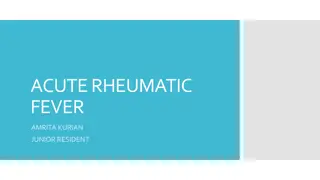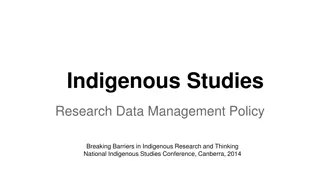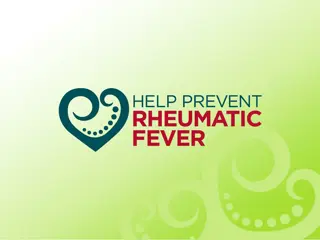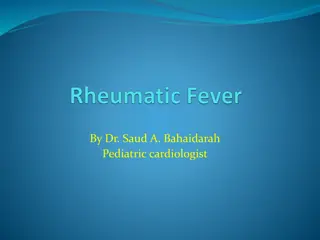Addressing Rheumatic Heart Disease Disparities in Indigenous Australians
Rheumatic heart disease (RHD) continues to disproportionately affect Indigenous Australians, particularly those living in remote areas, with a high incidence compared to the non-Indigenous population. Acute Rheumatic Fever (ARF) is a key precursor to RHD, often linked to social determinants and poor living conditions. Early diagnosis and effective treatment are crucial to prevent heart valve damage caused by recurrent ARF episodes. The stark contrast in RHD rates between Indigenous and non-Indigenous populations in Australia emphasizes the need for targeted interventions and improved healthcare access for Indigenous communities.
Download Presentation

Please find below an Image/Link to download the presentation.
The content on the website is provided AS IS for your information and personal use only. It may not be sold, licensed, or shared on other websites without obtaining consent from the author.If you encounter any issues during the download, it is possible that the publisher has removed the file from their server.
You are allowed to download the files provided on this website for personal or commercial use, subject to the condition that they are used lawfully. All files are the property of their respective owners.
The content on the website is provided AS IS for your information and personal use only. It may not be sold, licensed, or shared on other websites without obtaining consent from the author.
E N D
Presentation Transcript
Kathy Brown RHEUMATIC HEART DISEASE A plan of action for Queensland Senior Director Aboriginal and Torres Strait Islander Health Branch Queensland Health While acute rheumatic fever has become a rare curiosity in Australia s non-Indigenous population, its incidence in Indigenous Australians living in remote areas remains among the highest reported in the world. It is unlikely that such a stark contrast between two populations living within the same national borders exists for any other disease or on any other continent. Alex Brown, Malcolm McDonald, Tom Calma
The Rheumatic Heart Disease pathway Acute Rheumatic Fever is an autoimmune response to a group A streptococcus (GAS) bacterial infection. Social determinants such as poor living conditions are key drivers for onset of ARF and RHD. Symptoms such as fever, joint pain, sore throats and rashes are non-specific to the infection. Diagnosis should be based on assessment of symptoms combined with clinical history. Misdiagnosis occurs due to complexity of diagnosis may result in delayed or no treatment. Recurrence rate of ARF is greatest in first year after first episode. Rheumatic Heart Disease occurs when untreated, recurrent ARF episodes cause heart valve damage.
Acute Rheumatic Fever and Rheumatic Heart Disease in Queensland Queensland CVD Burden by condition, age and Indigenous status (2011) 88 percent The proportion of ARF notifications (total 1,151) for Indigenous Queenslanders (1,018) between 1999 and 2017 12 years The median age for onset of ARF for both Indigenous and non-Indigenous Queenslanders RHD Register data Indigenous 100% % contribution to CVD burden 75% 50% 25% 0% 30-34 00-04 05-09 10-14 15-19 20-24 25-29 35-39 40-44 45-49 50-54 55-59 60-64 65-69 70-74 75-79 80-84 85+ 05-09 60-64 85+ 00-04 10-14 15-19 20-24 25-29 30-34 35-39 40-44 45-49 50-54 55-59 65-69 70-74 75-79 80-84 Ischaemic heart disease Non-Indigenous Stroke Inflammatory heart disease 100% Peripheral vascular disease Rheumatic heart disease Other cardiovascular disease 100% 100% 100% % contribution to CVD burden 1,055 169 times The prevalence rate of RHD for Indigenous Australians compared with non- 100% 100% 75% % contribution to CVD burden % contribution to CVD burden % contribution to CVD burden 100% 75% 75% 75% % contribution to CVD burden % contribution to CVD burden 00-04 45-49 75% 75% % contribution to CVD burden 00-04 45-49 50% 75% The number of Indigenous Queenslanders with RHD currently listed on the Queensland RHD Register at July 2017 50% 50% 50% 50% 50% 25% 50% 25% 25% 25% 25% 25% 05-09 50-54 0% 30-34 10-14 15-19 20-24 25-29 35-39 40-44 45-49 50-54 55-59 60-64 65-69 70-74 75-79 80-84 85+ 05-09 60-64 85+ 00-04 10-14 0% 15-19 20-24 25-29 30-34 35-39 40-44 45-49 50-54 55-59 65-69 70-74 75-79 80-84 25% 05-09 50-54 0% 30-34 00-04 45-49 00-04 75-79 05-09 80-84 25-29 10-14 85+ 30-34 15-19 20-24 25-29 35-39 40-44 45-49 50-54 25-29 70-74 10-14 55-59 30-34 75-79 15-19 Other cardiovascular disease Stroke Rheumatic heart disease 60-64 35-39 80-84 20-24 65-69 40-44 85+ 25-29 70-74 45-49 75-79 50-54 80-84 55-59 00-04 85+ 60-64 00-04 45-49 0% 05-09 60-64 25-29 85+ 55-59 00-04 10-14 15-19 20-24 25-29 30-34 35-39 00-04 40-44 05-09 45-49 10-14 50-54 15-19 Stroke Ischaemic heart disease 55-59 20-24 65-69 30-34 70-74 75-79 80-84 30-34 10-14 15-19 20-24 25-29 35-39 40-44 45-49 50-54 55-59 60-64 65-69 70-74 75-79 80-84 85+ 05-09 60-64 85+ 00-04 10-14 15-19 20-24 25-29 30-34 35-39 40-44 55-59 65-69 70-74 75-79 80-84 05-09 10-14 15-19 20-24 65-69 70-74 75-79 80-84 85+ 60-64 05-09 35-39 40-44 45-49 50-54 65-69 10-14 70-74 15-19 0% 0% Ischaemic heart disease Inflammatory heart disease 20-24 30-34 05-09 10-14 15-19 20-24 25-29 35-39 40-44 45-49 50-54 55-59 60-64 65-69 70-74 75-79 80-84 85+ 30-34 05-09 10-14 15-19 20-24 25-29 35-39 40-44 45-49 50-54 55-59 60-64 65-69 70-74 75-79 80-84 85+ Indigenous Australians at December 2015 60-64 85+ 00-04 35-39 40-44 55-59 65-69 70-74 75-79 80-84 05-09 60-64 00-04 10-14 15-19 Other cardiovascular disease Stroke 20-24 25-29 30-34 35-39 40-44 50-54 55-59 65-69 Ischaemic heart disease Peripheral vascular disease Stroke Inflammatory heart disease 0% 00-04 Inflammatory heart disease 30-34 00-04 05-09 10-14 15-19 20-24 25-29 35-39 40-44 45-49 50-54 55-59 60-64 65-69 70-74 75-79 80-84 85+ Ischaemic heart disease Rheumatic heart disease Peripheral vascular disease Stroke Ischaemic heart disease Rheumatic heart disease Ischaemic heart disease Peripheral vascular disease Inflammatory heart disease Stroke Ischaemic heart disease 05-09 60-64 85+ 30-34 35-39 40-44 50-54 55-59 65-69 70-74 75-79 80-84 Peripheral vascular disease Rheumatic heart disease Other cardiovascular disease Inflammatory heart disease Inflammatory heart disease Stroke Other cardiovascular disease Peripheral vascular disease Rheumatic heart disease Peripheral vascular disease Other cardiovascular disease Rheumatic heart disease Peripheral vascular disease Inflammatory heart disease Other cardiovascular disease Rheumatic heart disease Other cardiovascular disease
Rheumatic Heart Policy Framework National Rheumatic Fever Strategy (2009) State-based register and control programs; education and training resources; data collection. Evaluation of the RHS (2017) Support an increased awareness of ARF and RHD among Aboriginal and Torres Strait Islander Queenslanders. National Partnership Agreement on Rheumatic Fever Strategy (2017-18) Commonwealth funding continued for three years (2017 18 to 2020 21). Queensland Queensland RHD Register and Control Program State-based register and recall system, improved clinical care, education and training, data collection. Queensland Aboriginal and Torres Strait Islander Rheumatic Heart Disease Action Plan 2018 2021
Rheumatic Heart Disease Action Plan 2018-2021 $4.5 million (over 3 years from 2018-19) New funding has been earmarked for activities under the RHD Action Plan: Support an increased awareness of ARF and RHD among Aboriginal and Torres Strait Islander Queenslanders Increased education for communities and clinicians on identifying the early symptoms of ARF and the important of early treatment Foster clinical knowledge on ARF and RHD across the health workforce, to support early diagnosis and treatment Enhance the Queensland RHD Register and Control Program to enable stronger linkages with acute cardiology services.
Priorities under the RHD Action Plan Promote, prevent, empower Ensure patients have the information they need and enable them to make the best decisions on their health. Improve the patient experience Provide patients with a comfortable clinical experience, coordinated streamlined service delivery and positive engagement with health care providers. Strengthen the approach Work cohesively to establish new relationships and partnerships with health service providers, and build on existing ones. Foster clinical knowledge Enable health professionals to appropriately prevent, diagnose and manage ARF and RHD. Enhance the Queensland RHD Register and Control Program Enable the Register to fully meet the needs of patients, other stakeholders and the requirements of the Rheumatic Fever Strategy and the Action Plan.























